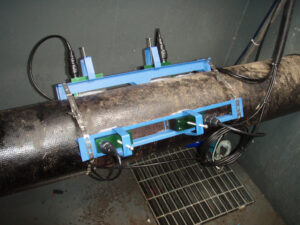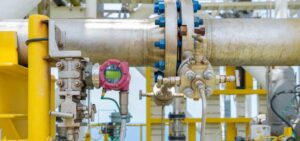If you are looking for a non-intrusive and accurate method to measure fluid flow in your process, ultrasonic flow meters could be the perfect solution.
In this article, we will discuss tips for selecting and installing ultrasonic flow meters in your process.
Understanding Ultrasonic Flow Meters
Before we dive into the tips, let’s first understand what ultrasonic flow meters are. Ultrasonic flow meters measure the velocity of a fluid by sending ultrasonic waves through a pipe or conduit and calculating the time it takes for the waves to travel. This is called Transit TIme ultrasonic measurement, which is about 95% of ultrasonic applications. Any easy analogy is when traveling by an airplane to a particular destination. The time travelled depends on wind speed either with or against the airplane. If one can replace an ultrasonic signal with an airplane and substitute wind speed with flow velocity, measuring the time it takes to arrive in destination, one can measure wind speed.
The speed or velocity of the fluid can then be used to calculate the flow rate. Ultrasonic flow meters can be used for various fluids, including liquids and gasses.
Tip 1: Consider the Type of Ultrasonic Flow Meter
There are two types of ultrasonic flow meters: transit-time and doppler. Transit-time meters are used for liquids and measure the time it takes for an ultrasonic wave to travel upstream and downstream in the fluid explained above.
Doppler meters, on the other hand, are used for liquids and gasses and measure the frequency shift of the ultrasonic waves caused by the movement of particles in the fluid. Where Transit time techniques are best in clean liquids, Doppler techniques are best with dirty liquids and must have particles or bubbles in the flow stream for accurate measurement. An analogy with this type of measurement is when getting caught speeding by a policeman. The policeman sends an ultrasonic signal to your car, the return frequency measured by the policeman’s speed gun is proportional to how fast you are driving.
Tip 2: Evaluate the Accuracy Requirements
The accuracy of the ultrasonic flow meter is an important consideration when selecting one for your process. The accuracy can be affected by factors such as temperature, pressure, and fluid composition. Make sure to evaluate the accuracy requirements of your process before selecting an ultrasonic flow meter. Transit time ultrasonic technology is far more accurate than Doppler techniques. Doppler should only be used with the fluid is so dirty or have high content of particles and bubbles no more than 40% in a flow stream.
Tip 3: Consider the Pipe Material and Size
Ultrasonic flow meters work best in large pipes and has limitations in small pipes because ultrasonic signals returned to the transmitter is too fast to measure in small pipes, usually less than 0.5 inches . Moreover because ultrasonic meters are installed outside the pipe, pipe material is very important in considering using ultrasonic technology. Pipes covered with insulation material, or has inside liners or material that are non-uniform like fiberglass or made out of several compound materials should be avoided. Consider the pipe material and size when selecting an ultrasonic flow meter.
Tip 4: Determine the Installation Location
The location of the ultrasonic flow meter in your process can affect its accuracy. Select an installation location that meets the manufacturer’s recommendations and is free from obstructions that could affect the fluid flow. Therefore pipe straight run requirements, such as before or after valves, other instruments, elbow, bends, curves etc. must be determined.
Tip 5: Ensure Proper Installation and Calibration
Proper installation and calibration are critical for the accuracy and reliability of ultrasonic flow meters. Make sure to follow the manufacturer’s instructions for installation and calibration, and consider hiring a professional to install if you are not experienced in the process.
Tip 6: Consider Maintenance Requirements
Like any other equipment, ultrasonic flow meters require regular maintenance to ensure accurate and reliable performance. Make sure to consider the maintenance requirements of the flow meter when selecting one for your process.
Tip 7: Evaluate the Cost
The cost of ultrasonic flow meters can vary widely depending on the type, accuracy, and features. Therefore, evaluate the flow meter’s cost in relation to the benefits it will provide to your process. Normally lower scan rates are cheaper but can only work in clean fluids while higher scan rates which are more expensive can accommodate a certain amount of particles or bubbles in fluid.
Tip 8: Consider the Compatibility with Other Equipment
Ultrasonic flow meters may need to be integrated with other equipment in your process, such as data acquisition systems or control systems. Make sure to consider the compatibility of the flow meter with other equipment when selecting one for your process.
Tip 9: Ensure Adequate Support from the Manufacturer
Select an ultrasonic flow meter from a manufacturer that provides adequate support, such as technical support, training, and documentation. This will ensure that you can get the most out of your flow meter and troubleshoot any issues.
Tip 10: Consider Future Expansion Needs
Finally, consider the future expansion needs of your process when selecting an ultrasonic flow meter. If you anticipate changes to your process in the future, make sure to select a flow meter that can accommodate those changes.
Conclusion
In conclusion, selecting and installing the right ultrasonic flow meter for your process is crucial to ensure accurate and reliable flow measurements. It’s important to consider factors such as the type of fluid being measured, the pipe size and material, and the required level of precision.
By following the tips outlined in this guide, including conducting a thorough site survey and working closely with a reputable vendor, you can ensure a successful installation and optimal performance of your ultrasonic flow meter.
As a result, you can improve process efficiency, reduce waste, and ultimately increase profitability with accurate flow measurements.





